How to Build the Perfect Inbound Sales Tech Stack in the AI Era | 2026
Article written by
Vipin Thomas

INSIDE THE ARTICLE
SHARE THIS ARTICLE
Summary
Modern sales teams don’t need more tools—they need the right ones. This blog breaks down the essential sales tech stack for inbound teams in the AI era—from CRM and lead routing to conversation intelligence and proposal automation. Learn how to build a stack that drives speed, alignment, personalization, and real revenue—without drowning in complexity or shelfware.
Look, when I started in sales, we thought we were fancy with Salesforce and some basic email automation. Now? The modern sales tech stack landscape changes every six months.
Last week, I was talking to a sales leader who was pulling her hair out. "We've got 47 different tools," she said, "and somehow we're still losing deals to companies half our size."
Sound familiar?
Here's the thing—throwing money at shiny new AI sales tools won't fix your sales problems. Trust me, I learned this the hard way. What you need is a sales tech stack that actually makes sense. One where everything talks to each other and your team isn't drowning in logins and passwords.
So let's cut through the noise. I'm going to walk you through what actually matters when building a modern sales tech stack for inbound sales teams. No vendor pitches, no magical thinking—just real talk about what works.
What is a Sales Tech Stack?
A sales tech stack is the collection of software tools that sales teams use to manage customers, automate processes, and close deals more efficiently.
Key components include:
- CRM systems (like Salesforce, HubSpot) for managing customer data and pipeline
- Sales engagement tools for automated outreach and follow-ups
- Lead generation platforms for finding prospects
- Communication tools like email and video conferencing
- Analytics dashboards for tracking performance
- Document management for proposals and contracts
The goal is to create an integrated system where these tools work together to streamline the sales process, reduce manual work, and provide better insights into what's driving revenue.
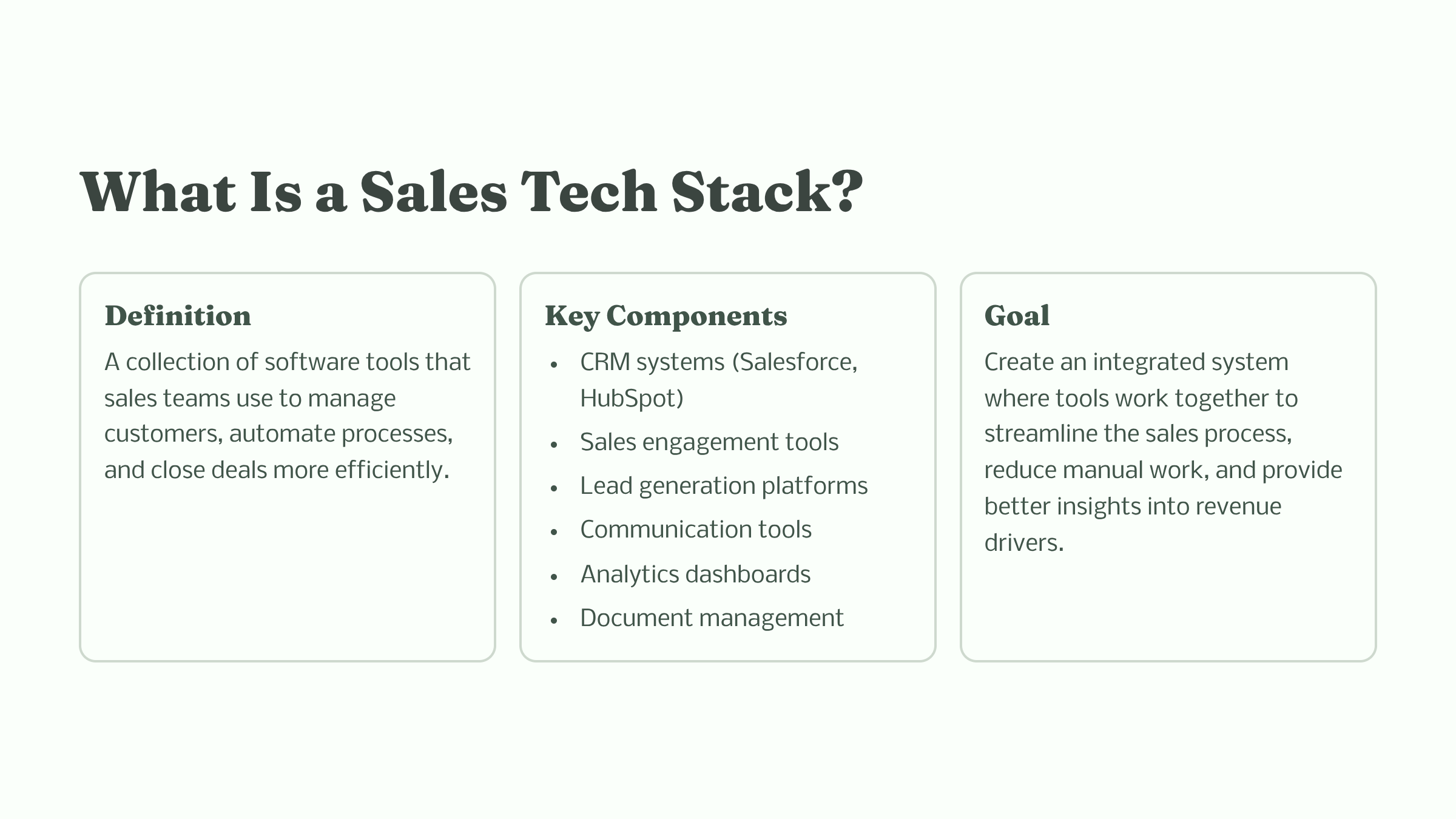
Why Your Current Sales Tech Stack Probably Isn't Working
Remember the last time you bought something expensive for your business? You probably did a ton of research online before even talking to a salesperson, right?
Yeah, your buyers do the same thing.
By the time they reach out, they've already formed opinions. They've compared you to competitors. They expect you to know who they are and what they need. And if you make them wait three days for a response? Game over.
The old sales automation playbook doesn't work anymore. You know, the one where:
- Sales reps manually update the CRM (when they remember)
- Leads sit in a queue for hours or days
- Every tool is its own island of information
- Nobody really knows which deals are at risk until it's too late
Modern inbound sales needs modern solutions. But here's where it gets tricky...
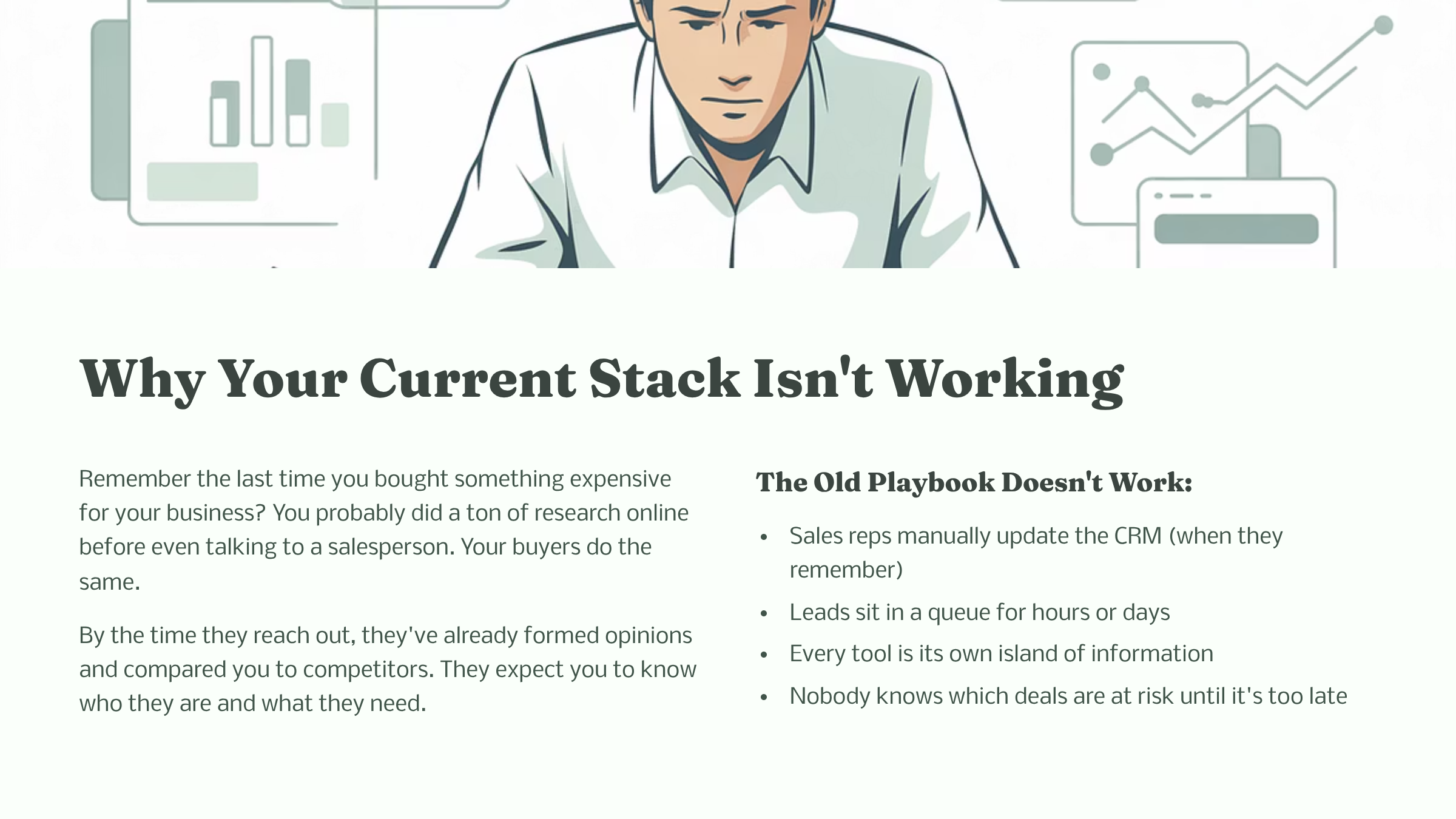
How to Build the Modern Sales Tech Stack (Without Losing Your Mind)
Alright, so you're probably thinking, "This sounds expensive and complicated." It can be. Or you can be smart about building your sales tech stack.
Phase 1: Get Your Foundation Right (Months 1-3)
Start here. Seriously.
- Pick a CRM and get everyone using it properly
- Set up basic inbound sales tools for lead routing so nobody waits
- Automate the stupid stuff (like data entry)
Just doing this will make a huge difference. I promise.
Phase 2: Add Intelligence (Months 4-6)
Now you can get fancy with your GTM tech stack:
- Add conversation or deal intelligence (pick your biggest pain point)
- Get your data cleaned up and enriched
- Automate more workflows with sales automation tools
This is where you start to feel like you're living in the future.
Phase 3: Go Faster (Months 7-9)
Time to accelerate your modern integrated sales tech stack:
- Roll out sales automation tools for consistent outreach
- Set up digital sales rooms for big deals
- Add AI-powered personalization tools that actually work
Your team should be moving noticeably faster by now.
Phase 4: Optimize Everything (Months 10-12)
The final push for your sales tech stack:
- Launch customer advocacy programs
- Add revenue enablement AI sales tools for RFPs and proposals
- Fine-tune based on what the data tells you
Now you're cooking with gas.
5 Things to Consider Before Building a Sales Tech Stack
Let me save you some pain. Here are the mistakes I see over and over with modern sales tech stacks:
1. Tool Addiction: "Ooh, shiny!" is not a buying strategy. Every AI sales tool you add makes things more complex. Be picky.
2. The "Set It and Forget It" Fantasy: These sales automation tools need care and feeding. Budget time for it, or watch them become expensive shelf-ware.
3. Ignoring the Human Element: Your team has to actually use this sales tech stack. If they hate it, it doesn't matter how good it is.
4. Data Garbage: Automating bad data just makes bigger messes, faster. Clean first, automate second.
5. Robot Syndrome: Don't let sales automation kill the human touch. Use tech to have better conversations, not avoid them.
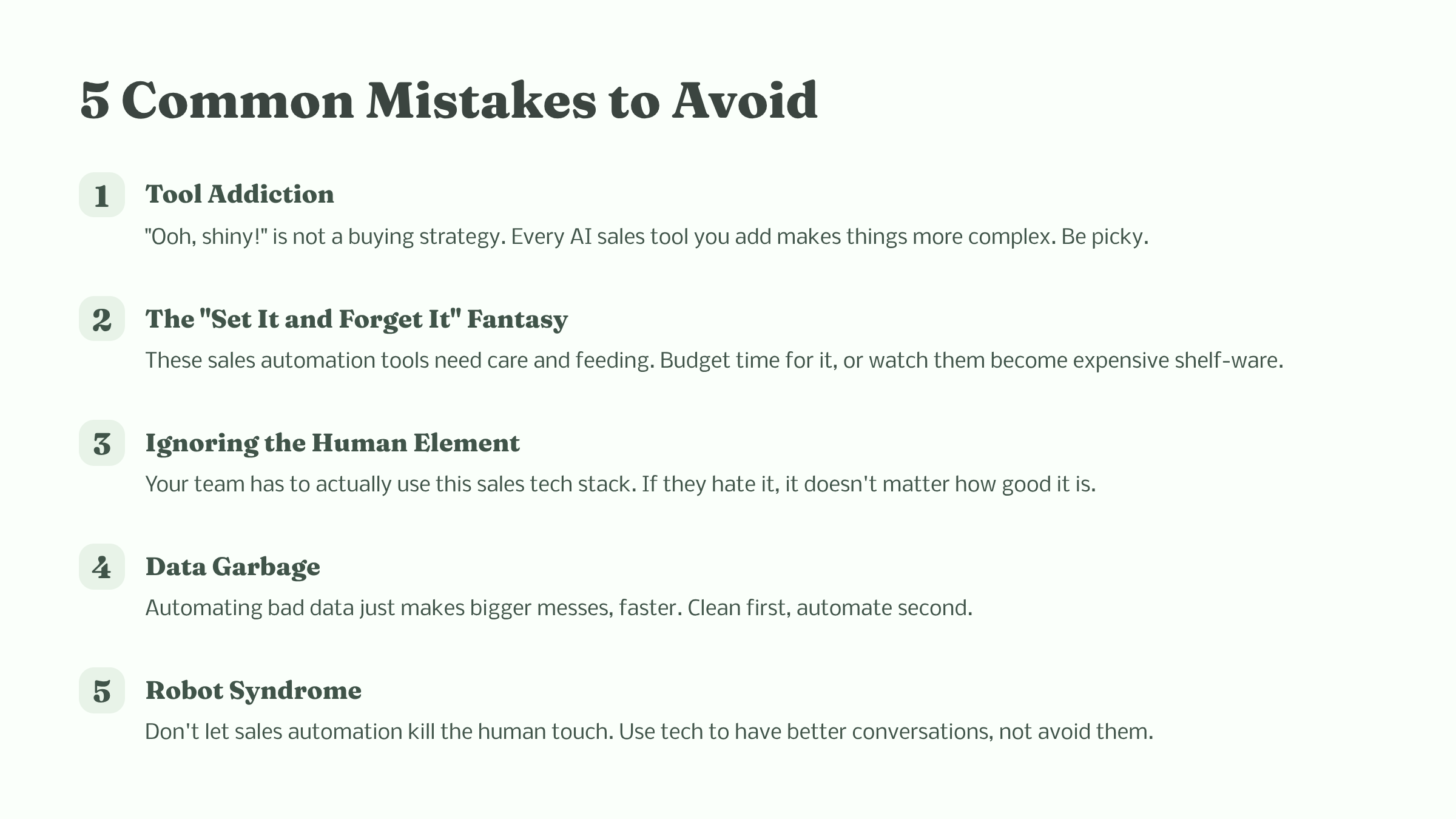
12 Sales Automation Tools You Actually Need in Your Sales Tech Stack
After going through this journey at SurveySparrow and watching friends at other SaaS companies figure out their GTM tech stack (and making plenty of mistakes myself), I've found there are really only about 10 categories of sales automation tools that matter. Let me break them down in plain English.
1. Getting Back to Leads FAST (Inbound Sales Tools)
The Problem It Solves: Ever notice how you're way more likely to buy from the company that calls you back first? Your customers are the same way. Speed wins deals. Period.
What to Look For:
- Something that lets prospects book meetings right from your website
- Smart routing so leads go to the right rep instantly
- Works with whatever forms you already have
- Doesn't make your prospects jump through hoops
Real Talk: I've seen companies go from 2-day response times to 2-minute response times. The difference in conversion? Night and day. Modern inbound sales tools like Chili Piper, Calendly, and others focus on this exact problem. Pick one that fits how your team actually works, not how the vendor thinks you should work.
2. Understanding What's Really Happening in Deals (AI Sales Tools for Deal Intelligence)
The Problem It Solves: Your sales team receives hundreds of calls every week. Buried in those conversations are gold nuggets—buying signals, concerns, and ,competitor mentions. But who has time to review every call?
What to Look For:
- Automatic analysis of calls and emails
- Red flags when deals are going sideways
- Insights your managers can actually use for coaching
- Plays nice with your other sales tech stack tools
Recent research analyzing 391 small businesses found a statistically significant relationship between AI applications in sales and revenue growth, as confirmed through multiple regression analysis of firm results
Real Talk: This stuff felt like science fiction five years ago. Now? AI-powered sales tools like Momentum.io and others can tell you which deals are at risk before your rep even knows something's wrong. Just don't expect it to replace good judgment—it's a tool, not a crystal ball.
3. Learning from Every Conversation (Conversation Intelligence in Your GTM Tech Stack)
The Problem It Solves: Your best rep closes 40% of their deals. Your average rep closes 20%. What's the difference? Without recording and analyzing calls, you're just guessing.
What to Look For:
- Clear recordings and accurate transcripts
- Insights about what top performers do differently
- Tracks things like who's doing most of the talking
- Helps with compliance (recording laws are no joke)
Real Talk: When we first rolled out conversation intelligence (using AI sales tools like Chorus, and others), reps were nervous. "Big Brother is watching!" But you know what? The good reps loved it. They finally had proof of what worked. And the struggling reps? They got better, fast.
4. Your Single Source of Truth (CRM - The Heart of Your Sales Tech Stack)
The Problem It Solves: Without a good CRM, you're flying blind. It's where everything about your customers lives—or at least it should be.
What to Look For:
- Easy enough that reps will actually use it
- Grows with your company
- Connects to everything else in your modern sales tech stack
- Gives you reports that make sense
According to a meta-analysis published in the International Journal of Current Science, CRM system adoption shows a positive correlation with improved sales performance. The review emphasizes that success depends not only on the system itself, but also on organizational support, employee training, and integration practices
Real Talk: Whether it's HubSpot, Salesforce, or something else entirely, your CRM is like the foundation of a house. Get it wrong, and everything else in your GTM tech stack becomes a headache. Get it right, and everything else just... works.
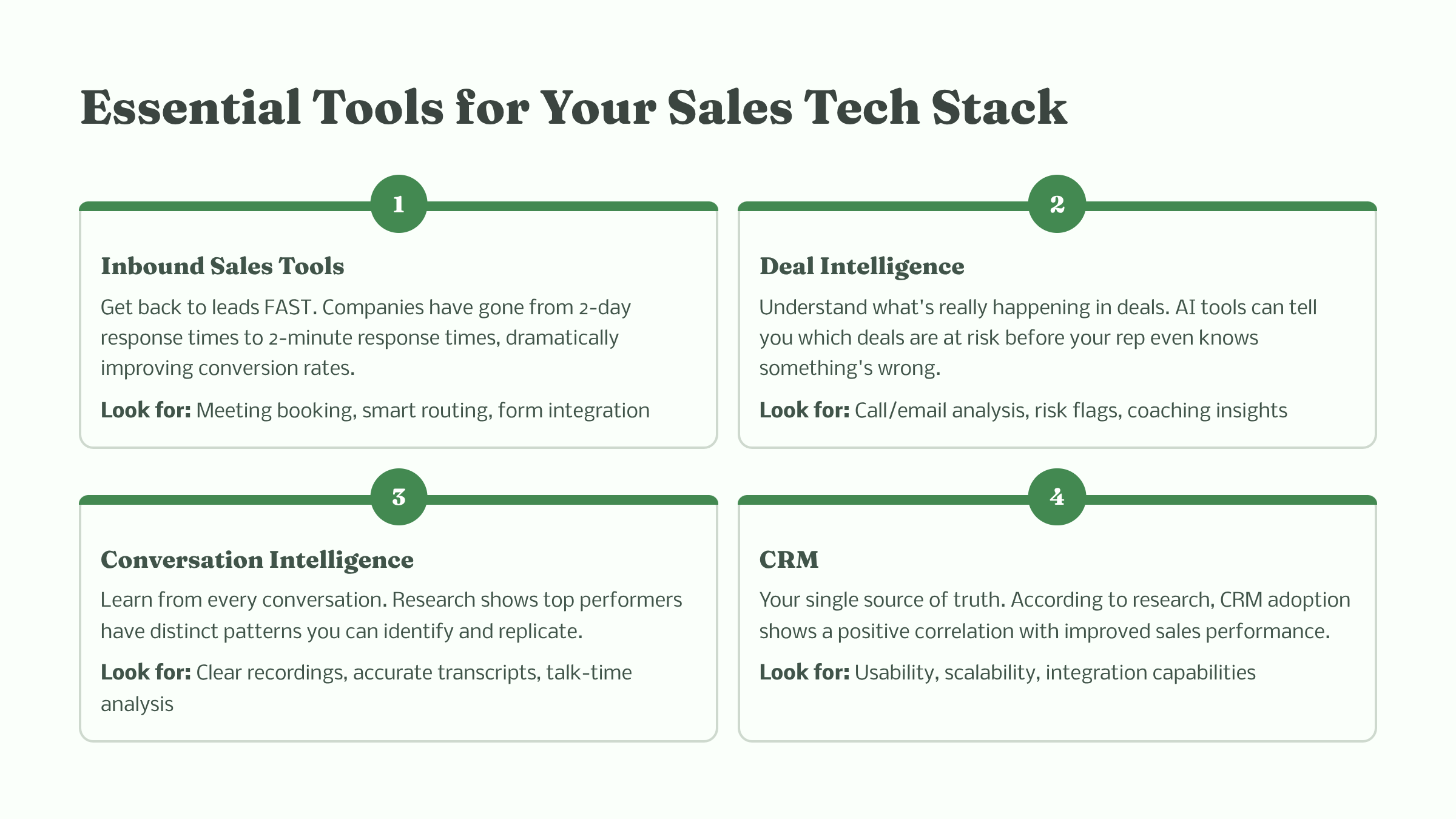
5. Consistent Outreach That Doesn't Sound Robotic (Sales Automation Tools)
The Problem It Solves: Following up with 50 leads manually? Good luck with that. But blast the same generic email to everyone? That's a fast track to the spam folder.
What to Look For:
- Helps you reach out across email, phone, LinkedIn—wherever your buyers are
- Personalization that actually sounds personal
- Shows you what's working and what isn't
- Keeps your team on track without micromanaging
Real Talk: Sales automation tools like Salesloft, Outreach, and similar platforms are great, but here's the catch: garbage in, garbage out. If your messaging sucks, automation just helps you suck at scale. Start with good messaging, then automate.
6. A Better Way to Manage Complex Deals (Digital Sales Rooms for Modern Sales Teams)
The Problem It Solves: Ever tried to buy something expensive for your company? It's a nightmare of emails, attachments, and "Wait, which version is the latest?" Digital sales rooms fix that mess.
What to Look For:
- One place for all deal documents
- Shows you who's actually looking at your stuff
- Keeps everyone on the same page (literally)
- Secure enough for paranoid IT departments
Real Talk: Not every deal needs this. But for those big, complex sales with multiple stakeholders? Game changer. Platforms like Aligned, Dock, and others in this space can cut weeks off your sales cycle. I've seen it happen.
7. Knowing Everything About Your Prospects (Data Enrichment in Your Sales Tech Stack)
The Problem It Solves: You can't personalize if you don't know anything about your prospect. But manually researching every lead? Ain't nobody got time for that.
What to Look For:
- Accurate company and contact info
- Updates automatically
- Tells you when accounts are showing buying signals
- Doesn't creep out your prospects with TMI
Real Talk: Tools like Clay, ZoomInfo, and Clearbit can tell you a lot. Sometimes, is usually too much. The key is using this data to be helpful, not creepy. "I saw you're hiring 10 engineers" is helpful. "I noticed you vacationed in Cabo last week" is creepy. Don't be creepy.
8. Making Everything Work Together (Sales Automation Platforms)
The Problem It Solves: Great, you've got 10 awesome AI sales tools. But if your team spends half their day copying data between them, what's the point?
What to Look For:
- Connects all your sales tech stack tools without coding
- Reliable (broken automations = angry team)
- Easy enough that non-techies can use it
- Scales with your needs
Real Talk: Make, Zapier, and similar tools are like digital duct tape—they hold your modern sales tech stack together. Start simple. Automate one annoying task. Then another. Before you know it, you've given your team hours back every week.
9. Outreach That Actually Gets Responses (Personalization Tools for Inbound Sales)
The Problem It Solves: "Dear [FIRST_NAME]" doesn't cut it anymore. Buyers can smell lazy automation from a mile away.
What to Look For:
- Goes beyond mail merge
- Helps craft messages that sound human
- Works across all your channels
- Tracks what messaging works
Real Talk: AI-powered personalization tools like Buzz, Lavender, and others can help, but remember—personalization isn't about mentioning their college mascot. It's about understanding their actual problems and speaking to them. The tool just makes it faster.
10. Turning Happy Customers into Your Sales Team (Customer Advocacy in Your GTM Tech Stack)
The Problem It Solves: Your prospects trust your customers way more than they trust you. But getting customers to actually help with references is usually like pulling teeth.
What to Look For:
- Makes it easy for customers to help
- Matches the right reference to the right prospect
- Tracks the impact on deals
- Doesn't annoy your customers
Real Talk: Platforms like Deeto and ReferenceEdge work, but only if you've got happy customers to start with. Fix your product and service first, then worry about advocacy tools.
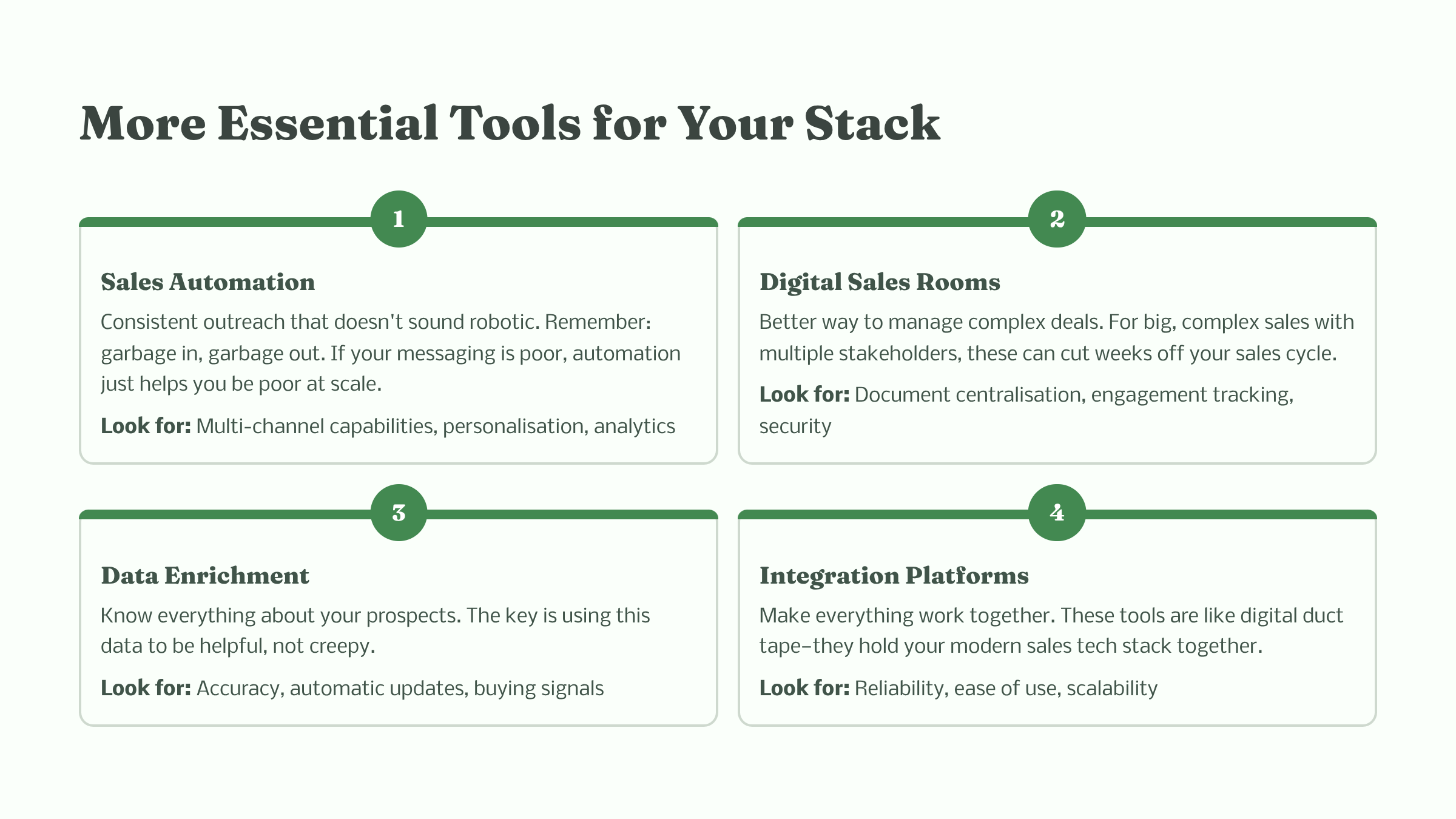
11. Automating the Boring Stuff (Revenue Enablement AI Sales Tools )
The Problem It Solves: You know what kills sales productivity? RFPs. Proposals. Security questionnaires. The stuff that has to get done but doesn't directly close deals.
What to Look For:
- AI sales tools that actually understand your business
- A library that stays up-to-date
- Collaboration without the chaos
- Responses that don't sound like robots were written by them
Real Talk: This is a newer category, but it's catching on fast. Why? Because sales teams waste TONS of time on this stuff. AI-powered solutions like SparrowGenie, Loopio, and others can turn a 10-day RFP process into a 2-day one. That's eight extra days to actually sell.
How to Pick the Right Sales Tech Stack Tools (A Simple Framework)
When you're evaluating any tool for your GTM tech stack, ask yourself:
Does This Solve a Real Problem?
- Can you quantify the pain?
- Will fixing it actually impact revenue?
- Or are you just buying because a competitor has it?
Will It Play Nice with Your Existing Sales Tech Stack?
- Does it integrate with what you have?
- How much duct tape (aka custom integration) will you need?
- What happens to your data if you switch later?
Will People Actually Use It?
- Show it to your grumpiest sales rep. What do they say?
- How long before someone's productive with it?
- Does it make their job easier or harder?
Can You Trust the Vendor?
- Are they profitable or burning VC money?
- Does their roadmap align with where your sales tech stack is going?
- When you call support, do you get actual help?
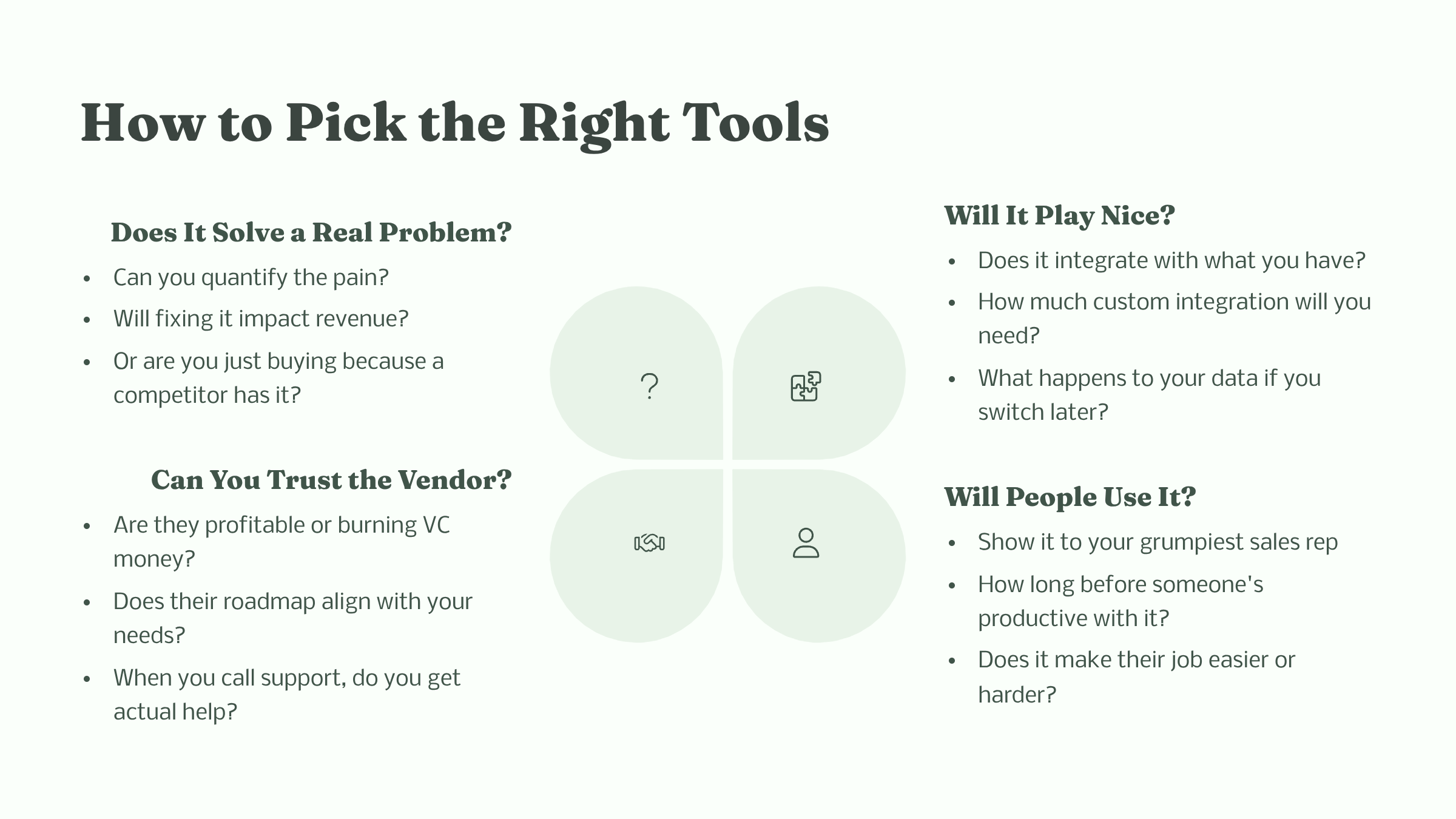
Benefits of a Robust Sales Tech Stack
A robust sales tech stack acts as a force multiplier for sales teams, transforming how they operate and dramatically improving outcomes. When properly implemented and integrated, these tools create a competitive advantage that goes far beyond simple automation.
Key benefits of a robust sales tech stack:
1. Increased efficiency - Automates repetitive tasks like data entry, follow-ups, and reporting, freeing up time for actual selling.
2. Better data visibility - Centralized customer information and real-time analytics help teams make informed decisions and spot trends quickly.
3. Improved lead management - Better tracking and nurturing of prospects through the entire sales funnel, reducing missed opportunities.
4. Enhanced productivity - Sales reps can focus on high-value activities instead of administrative work, leading to more deals closed.
5. Consistent processes - Standardized workflows ensure nothing falls through the cracks and maintain quality across the team.
6. Scalability - Systems can handle growth without proportionally increasing administrative overhead or complexity.
7. Better customer experience - Faster response times, personalized communications, and smoother handoffs between team members.
8. Accurate forecasting - Real-time pipeline data enables more precise revenue predictions and strategic planning.

Looking Ahead for Sales Tech Stacks (Without the Crystal Ball)
The modern sales tech stack landscape changes fast. Like, really fast. Here's what to keep an eye on:
AI Everything: It's not hype anymore. AI sales tools are becoming table stakes. But watch out for "AI washing"—not everything that claims AI actually uses it meaningfully.
The Platform Wars: Big vendors want to own your entire GTM tech stack. Specialists want to be the best at one thing. There's no right answer—pick what works for you.
Privacy Gets Real: Regulations are tightening. Make sure your sales tech stack doesn't turn into a liability.
Customer Experience Bleeds Into Sales: The line between sales and success tech is blurring. Plan your sales tech stack accordingly.
5 Key Steps to Build Your Sales Tech Stack (For Real This Time)
1. Audit What You Have: List every tool your team uses in your current sales tech stack. I bet it's more than you think.
2. Find the Biggest Pain: What's the one thing that drives everyone crazy? Start there.
3. Talk to Your Team: They know what's broken in your modern sales tech stack. Listen to them.
4. Start Small: Pick one sales automation tool to fix. Nail it. Then move to the next.
5. Measure Everything: If you can't measure the impact of your sales tech stack, you can't improve it.
Now, it's time we answer the common questions everyone asks about sales tech stack.., here we go...
Answering 15+ Common Questions Everyone Asks About Sales Tech Stack
1. Wait, what exactly IS a GTM Sales tech stack?
Think of it like this: remember playing with LEGOs? Each block does something specific, but the magic happens when you connect them all together. That's your GTM tech stack—a bunch of software tools that work together to help you find customers, close deals, and keep them happy.
2. What sales tech stack tools do I absolutely NEED to get started?
Honestly? Start simple with your modern sales tech stack:
- A CRM to track everything (like HubSpot or Salesforce)
- Inbound sales tools to route leads quickly (so they don't ghost you)
- Basic sales automation (because following up manually is for suckers)
- A way to analyze what's working (data beats guessing every time)
Everything else? Add it when you actually need it, not because some blog told you to.
3. Should I buy one big platform or a bunch of specialized sales tech stack tools?
Ah, the eternal question for your GTM tech stack. Here's my take:
Go all-in-one if:
- You're small and want simplicity
- You don't have a tech team
- "Good enough" works for you
- You hate dealing with multiple vendors
Go best-of-breed if:
- You need specific AI sales tools that the big guys don't have
- You've got people who can manage integrations
- You're okay with more complexity for better results
- You like being able to swap out tools
4. What's lead routing, notice, and why should I care in my inbound sales tech stack?
You know when you fill out a form online and nobody calls you back for three days? That's bad lead routing. Good inbound sales tools for lead routing mean the right salesperson contacts you within minutes, not days. It's literally the difference between winning and losing deals.
5. How is "conversation intelligence" different from just recording calls in my sales tech stack?
Recording calls is like taking a photo. Conversation intelligence AI sales tools are like having someone analyze that photo and tell you, "Hey, notice how the prospect's body language changed when you mentioned pricing?" It finds patterns, spots problems, and helps reps get better. Way more useful than a pile of recordings nobody listens to.
6. What the heck is a digital sales room in a modern sales tech stack?
Imagine trying to buy a house through email. Nightmare, right? Documents everywhere, versions getting confused, nobody knows what's happening. A digital sales room is like having a private website for each deal where everyone can see the same info, track progress, and actually get stuff done. It's especially great for big, complicated deals.
7. How do sales automation tools actually help sales teams?
Picture this: your rep closes a deal. Normally, they'd spend 30 minutes updating five different systems in your sales tech stack. With sales automation, it happens instantly. Lead comes in? Automatically enriched with company data. Meeting ends? Notes pushed to CRM. Follow-up needed? Task created automatically. It's like having a super-organized assistant who never sleeps.
8. What's a revenue enablement platform in AI sales tools?
You know all that tedious stuff that eats up selling time? RFPs that take forever, proposals that need input from five departments, security questionnaires that make you want to cry? Revenue enablement AI sales tools handle that. They use AI to pull answers from your knowledge base, coordinate everyone's input, and get it done in days instead of weeks. Tools like SparrowGenie, Loopio, and others are making this stuff way less painful.
9. How does AI actually help in sales tech stack tools?
AI sales tools in your modern sales tech stack aren't about robots taking over. It's more like having a really smart intern who:
- Notice patterns you miss ("Hey, deals with procurement involved take 40% longer")
- Suggests next steps ("Based on similar deals, schedule a technical demo now")
- Writes first drafts ("Here's a follow-up email based on your call notes")
- Flags risks ("This deal hasn't had activity in 10 days—might want to check in")
10. How much should I budget for a sales tech stack?
Rule of thumb for your GTM tech stack:
- Software: 10-20% of your sales and marketing budget
- Implementation: About the same as first-year software costs (yeah, really)
- Training: Another 20-30% annually (or watch adoption fail)
- Maintenance: 15-25% for integrations and updates
Start small. Prove ROI. Then expand. Don't blow your budget on day one.
11. What are the biggest mistakes people make with their sales tech stack?
Oh boy, where do I start with modern sales tech stack mistakes?
- Buying too many AI sales tools at once (death by a thousand logins)
- Thinking tools fix process problems (they don't)
- Skipping training ("It's intuitive!" ...it's not)
- Not measuring results (then wondering if your sales tech stack is working)
- Ignoring user feedback (hello, expensive shelf-ware)
- Automating broken processes with sales automation tools (now they're just faster broken processes)
12. How do I know if my sales tech stack is working?
Simple. Ask yourself about your GTM tech stack:
- Are deals closing faster?
- Is your team spending more time selling?
- Can you see what's actually happening in your pipeline?
- Are reps happy or constantly complaining about your sales automation tools?
- Is revenue growing?
If you answered "no" to any of these, something's not working in your sales tech stack.
13. What about data privacy and compliance for sales tech stacks?
This stuff matters more every year for your modern sales tech stack. Make sure:
- Your sales tech stack vendors have proper certifications (SOC2, GDPR, etc.)
- You know where data lives and who can access it
- You've got consent management figured out
- Your team knows the rules
- You can delete data when required
Boring? Yes. Important? Absolutely. Ignore this at your peril.
14. What's the difference between enrichment and intent data in sales tech stacks?
Enrichment: Finding out facts about companies (size, industry, tech they use)
Intent data: Seeing behaviors that suggest they're ready to buy (visiting pricing pages, downloading whitepapers)
Both are useful in your sales tech stack. Enrichment helps you personalize. Intent helps you prioritize. Use both, but don't be creepy about it.
15. Should I build custom sales tech stack tools or buy?
Unless you're a software company, buy. Seriously. Building AI sales tools seems cheaper until you factor in:
- Developer time
- Maintenance forever
- No vendor support
- Missing features you didn't think of
- Security updates
Buy proven sales tech stack tools. Customize them if needed. Build only if you absolutely must.
16. How do I get my team to actually use these sales automation tools?
The million-dollar question for any sales tech stack! Here's what works:
- Include them in the selection (people support what they help create)
- Start with volunteers, not mandates
- Show wins early and often
- Make heroes of early adopters
- Address concerns honestly about your modern sales tech stack
- Tie usage to things they care about (like commission)
- Make it easier than the old way
Force it? Watch it fail. Make your sales tech stack valuable? Watch adoption soar.
17. How often should I review my sales tech stack?
Weekly: Check usage and adoption metrics
Monthly: Review integration health and data quality
Quarterly: Assess ROI and user satisfaction of your GTM tech stack
Yearly: Big picture evaluation and strategic planning
But also review your sales tech stack when:
- Your business model changes
- You acquire another company
- Growth stalls
- The team revolts
18. What integrations matter most in a sales tech stack?
The ones that eliminate double data entry. Usually, in your modern sales tech stack:
- CRM ↔ Everything else
- Email ↔ CRM
- Calendar ↔ CRM
- Marketing automation ↔ CRM
- Support system ↔ CRM
Seeing a pattern? Your CRM is the hub. Everything else in your sales tech stack should speak to it fluently.
19. How do I future-proof my sales tech stack choices?
You can't predict the future, but you can be smart about your GTM tech stack:
- Pick vendors who are growing, not dying
- Choose sales automation tools with open APIs
- Keep your data clean and portable
- Build processes, not tool dependencies
- Stay educated on what's coming in AI sales tools
- Leave room in your architecture for change
Most importantly: be ready to evolve. The sales tech stack that got you to $10M won't get you to $100M.
The Bottom Line
Building a great sales tech stack isn't about having the most AI sales tools or the newest features. It's about creating a system that helps your team sell more effectively.
Every company is different. What works for a 10-person startup won't work for a 1,000-person enterprise. And that's okay.
The key is to start somewhere, learn as you go, and always—always—keep your focus on what actually drives revenue with your GTM tech stack.
Because, at the end of the day, that's what this is all about—not the tech, but the results.
Now stop reading and go build something great.
Ready to see how AI can transform your RFP process?
VP Revenue Operations at SurveySparrow and Business Unit head for SparrowGenie. With 18+ years in B2B SaaS—including leadership roles at Freshworks and MangoApps—I’ve led go-to-market, customer success, and revenue operations across high-growth teams. My focus consistently has been building predictable, repeatable revenue engines, aligning cross-functional teams, and driving outcomes that scale. SparrowGenie emerged from that journey—born as an internal fix for RFP bottlenecks, it’s now evolving into a category-defining product in sales automation and enablement.
Frequently Asked Questions (FAQs)
Related Articles

Responsive RFP: The Complete Guide to Creating Winning Proposal Responses

Proven Methods for Customizing Proposals Across Different Industries
